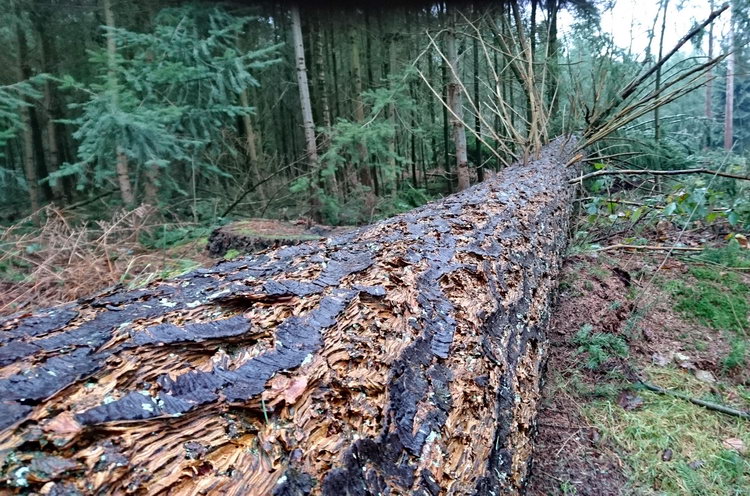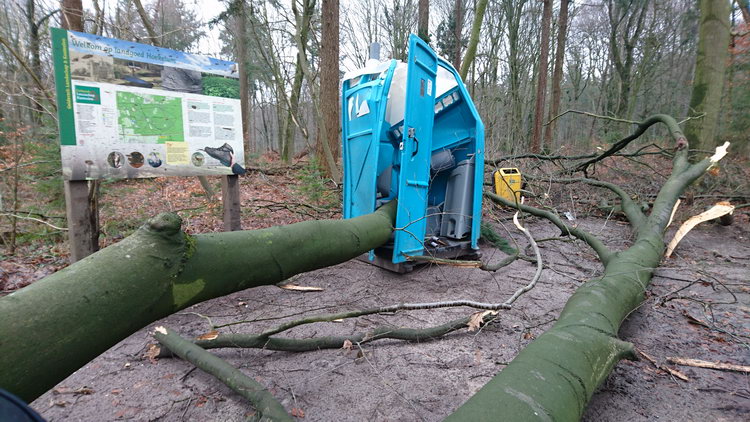Blog
Storm!
Last Thursday we had the biggest storm for years. 66 lorries were blown over on the road and the entire national rail network was shut down — I think for the first time ever. At the weekend, the official trails on the Heuvelrug were shut, which was fair enough as a lot of people go quite fast there and you could imagine dangerous situations developing with trees down all over the place, but what about the woods on the other side of Wageningen where you don't have to stick to designated paths? A small group of us ventured out on Saturday morning to see how it was.
[text continues under photo]

It was indeed quite dramatic with large numbers of very big trees all over the place. There were a lot of Scots Pines, I suppose because their needles caught the wind, and a lot of very tall trees, probably as they caught the wind sticking out above the canopy. It was notable that many were not uprooted, but snapped off part way up. Fortunately, there is quite a network of paths, so it was no problem to wend our way round some, and crawl under or over others. There were also thousands of smaller branches over the paths, and many of them smooth, wet and slippery, so we had a lot of practice hopping over them whilst avoiding touching them at an angle with our front wheels, which would then be a recipe for a crash. In places, it was a bit like being in snow; slow progress and high energy expenditure. All in all, it was quite spectacular, especially where the trees found something other than trees to fall on.

New Year's Resolution
According to my newspaper last weekend, it is about now that most people stop keeping the resolutions they made for the New Year. I don't have that problem because I haven't started doing anything about my New Year's resolution yet! At New Year, I signed up for the Vulkan Bike Eifel Marathon, so my challenge for the year is going be to train for that. And it will be a challenge as well; it is 2 000 height meters in 85 km. The 85 km will not be such an issue, but the height is getting on twice as much as I have ever done in a day before. The profile is quite scary as well:
[text continues under picture]
However, scary as it might be, various people who know more about these things than I do, have told me that it ought to be possible. So, on the random assumption that six months training will be enough, I've drawn up a scheme where every couple of weeks I go a bit further, starting from the 40 km that I normally do with the club on a Saturday and building up to 80-90 km. That's fine for the kilometres, but seeing there isn't a great deal of height meters around here anyway, I'm just going to have to hope that selecting the hillier bits around here will be sufficient, even if I'm not often going to go above the thousand meters.
The marathon is organised by VulkanBike (named because it is in the volcanic region of the Eifel) and has the advantage of taking place in spectacular scenery, like the view below:
[text continues under picture]

Dog-weather
When the English say that it is raining cats and dogs, the Dutch say it is dog weather (hondenweer). I don't know why, I don't think either cats or dogs like to be out in miserable weather. Unlike mountain bikers (or at last some). But today the sun was shining, it was warmer and there was much less iced water on the ground than a week ago. Nevertheless, that meant it was dog weather. There were more dogs out in the woods today than I've seen for ages. Sometimes dogs in the woods are a bit aggressive, I've been bitten twice in recent years. But today, I think they were so happy to be out after being cooped up inside after the bad weather recently, that there was not even a growl or raised hackle as I cycled past them. Everyone was happy in the woods today.
Cold!
It snowed last night, and this morning it was round about freezing. Most of the club were sensible enough not to go out in the cold, so it was just me and one other mountain biker this morning. I put a couple of extra layers on and thought that would be enough, but that turned out not be quite right. Not only was it snowy, the ground was also very swampy, I guess because it was either frozen or saturated lower down. To make matters worse, the snow acted as camouflage for a number of quite deep puddles. So that meant that, on several occasions, my foot went down into a lovely mixture of water/snow/ice, deeper than the top of my boot, allowing icy water to seep in around my feet. Add to that a spray of damp snow from my back wheel onto my backside and I was very forcibly reminded of just how much colder damp snow at zero feels than much lower temperatures. My wife made it clear to me before I set off that she thought I was insane going out in such weather, so was she right? Well, maybe a little, but it was incredibly beautiful despite the cold, with the fresh snow lying everywhere, the snow gave some extra technical challenges and yes, despite the cold it was well worth it.
Back to the future
I had been looking forward to the Veluwe Challenge for the past few weeks, with the steep and slippery slopes of the Goudsberg as its high point. However, that was not to be as, on Tuesday, I pulled a muscle in my back by simply getting out of a chair after a meeting. It is also possible that then running for the train was not the smartest thing to do, but it was clear that cycling a Challenge would be considerably less smart. Nevertheless, sitting around all day was probably also not what the back would want, so in the afternoon I went for a short ride in the woods. The leaves are beginning to change colour, especially of the Birches and American Oak and there was plenty of blue sky and sunshine, so it was all quite spectacular. And amazingly, my back did indeed feel much better by the time I got back.

Zeddam
Yesterday we cycled the Montferland route (officially 'Zeddam') and it was glorious. We arrived in dense fog and for a few minutes, I wondered if it was going to be miserable but the sun soon came out and it was perfect. Not too hot or too cold and just enough moisture in the air to make the sun rays through the trees spectacular. The trail has over 400 height meters in its 25 km length, which means that it is one of the hilliest in the neighbourhood (readers of this blog who think that mountain biking is something you do in mountains can stop laughing) and slopes of up to 15 degrees, so it certainly felt different compared to the virtually horizontal areas round Wageningen. The woods there are also much more diverse with a richer understory of herbaceous plants and some lovely moss-coated areas. And to cap it all, we finished with coffee and apple tart. What more could you want?




